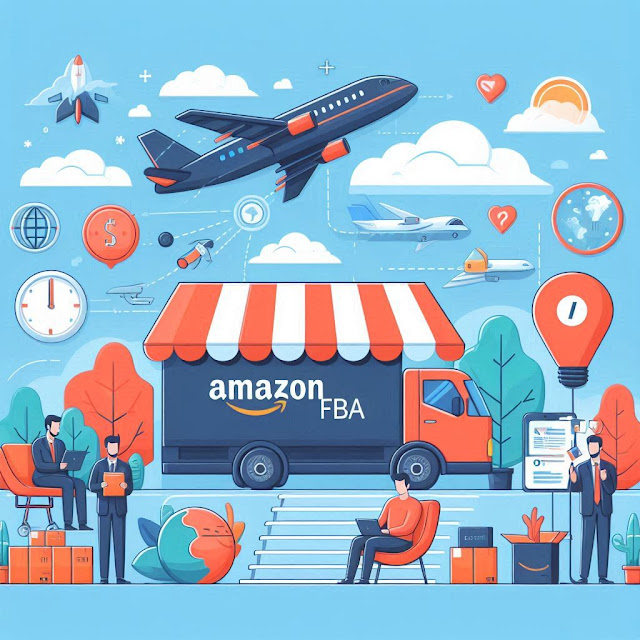Dreaming of starting your own online business? Amazon FBA (Fulfillment by Amazon) offers a golden opportunity to tap into the e-commerce giant’s vast customer base. With Amazon handling the logistics—shipping, returns, customer service—you can focus on what you do best: sourcing and selling products. But how do you get started? In this guide, we’ll walk you through the essential steps to launch your Amazon FBA business, answer frequently asked questions, and provide valuable tips to set you on the path to success.
1. What Is Amazon FBA and Why Should You Start?
Amazon FBA allows you to store your products in Amazon’s fulfillment
centers. When a customer makes a purchase, Amazon picks, packs, and ships the
order. They even handle returns and customer service. This hands-off approach
is perfect for entrepreneurs who want to scale their business without the
headache of logistics.
Why FBA? According to recent statistics, over 50% of Amazon sellers use FBA, and
many report significant revenue growth. It’s a proven model that offers global
reach and access to Amazon Prime’s loyal customer base.
2. Step-by-Step Guide: How to Start
Amazon FBA
Step 1: Choose a Profitable Niche and Product
Your success hinges on picking the right product. Research is key. Use tools
like Jungle Scout or Helium 10 to analyze trends, competition, and demand. Look
for products with high demand but low competition.
Pro Tip: Avoid overly saturated markets and focus on products with a clear value
proposition. Private labeling can also give you an edge by allowing you to
build a unique brand.
Step 2: Set Up Your Amazon Seller Account
Once you’ve chosen your product, it’s time to set up your Amazon Seller
account. You can choose between an Individual or Professional account. The
Professional account is ideal if you plan to sell more than 40 items per month.
Actionable Tip: Have your business information, tax details, and bank account ready when
signing up. This will streamline the process and get you up and running faster.
Step 3: Source Your Products
Finding a reliable supplier is crucial. Consider using platforms like Alibaba
or Global Sources to find manufacturers. Don’t just settle for the first
supplier you find—negotiate terms, request samples, and ensure the quality
meets your standards.
Insider Tip: Building a good relationship with your supplier can lead to better
pricing and priority production. Always order samples before committing to a
large order.
Step 4: Create a Winning Product Listing
Your product listing is your storefront. High-quality images, compelling
descriptions, and relevant keywords are non-negotiable. Use bullet points to
highlight key features and benefits.
SEO Insight: Optimize your listing with keywords that your target audience is
searching for. Tools like Google Keyword Planner and Amazon’s own search bar
can help you find the right terms to include.
Step 5: Ship Your Products to Amazon’s Fulfillment Centers
Once your products are ready, it’s time to send them to Amazon’s fulfillment
centers. Follow Amazon’s FBA shipping guidelines closely to ensure smooth
processing.
Quick Tip: Use Amazon’s partnered carriers for discounted shipping rates. Properly
label your products to avoid delays in the fulfillment process.
Step 6: Launch Your Product
Your product is live—now what? A successful launch can make or break your
Amazon FBA business. Use PPC (Pay-Per-Click) advertising to drive traffic to
your listing. Encourage reviews by following up with customers.
Did You Know? According to Amazon, products with over 50 reviews are more likely to
convert sales. Consider offering a discount or running a promotion to encourage
early reviews.
Step 7: Monitor and Optimize
Your work doesn’t stop once your product is live. Regularly monitor your sales,
inventory, and customer feedback. Adjust your pricing, PPC campaigns, and
listing details as needed.
Pro Strategy: Use tools like Sellics or FeedbackWhiz to automate review requests and
track performance metrics. Stay agile and be ready to pivot based on what the
data tells you.
3. Frequently Asked Questions About
Starting Amazon FBA
Q: How much money do I need to start Amazon FBA?
A: The cost to start Amazon FBA varies depending on your product and business
model. On average, you’ll need between $2,500 and $5,000 to cover inventory,
Amazon fees, and marketing.
Q: Do I need to have a registered business to start?
A: While not mandatory, having a registered business (LLC, for example) can
offer legal protections and make the process smoother. It also looks more
professional to suppliers and customers.
Q: How long does it take to start making money with Amazon FBA?
A: This depends on various factors, including your product choice, market
demand, and marketing efforts. Most sellers start seeing profits within 3 to 6
months, but it can take longer.
Q: What are the risks of starting Amazon FBA?
A: Like any business, Amazon FBA comes with risks. Common challenges include
competition, inventory management, and changes in Amazon’s policies. However,
with proper research and planning, these risks can be mitigated.
4. Success Stories: Real-Life Examples
of Amazon FBA Entrepreneurs
Story 1: The Fitness Guru
John, a fitness enthusiast, started selling resistance bands through Amazon FBA
in 2020. He identified a growing trend in home workouts and capitalized on it.
Within a year, he scaled his business to six figures by expanding his product
line and leveraging social media for marketing.
Story 2: The Stay-at-Home Mom
Sarah, a stay-at-home mom, turned her passion for eco-friendly products into a
thriving Amazon FBA business. She started with bamboo toothbrushes and quickly
became a top seller in her category. Her secret? Focusing on quality and
customer service, leading to repeat business and loyal customers.
Conclusion
Starting an Amazon FBA business can be incredibly rewarding, but it
requires careful planning, research, and execution. By following the steps
outlined in this guide, you’ll be well on your way to building a profitable
e-commerce business that leverages Amazon’s powerful platform. Whether you’re
looking to start a side hustle or replace your 9-to-5, Amazon FBA offers the
tools and resources to make it happen. Don’t wait—start your Amazon FBA journey
today and take the first step toward financial freedom.
Remember, success with Amazon FBA doesn’t happen overnight, but with
persistence and the right strategy, the sky's the limit. Happy selling!



